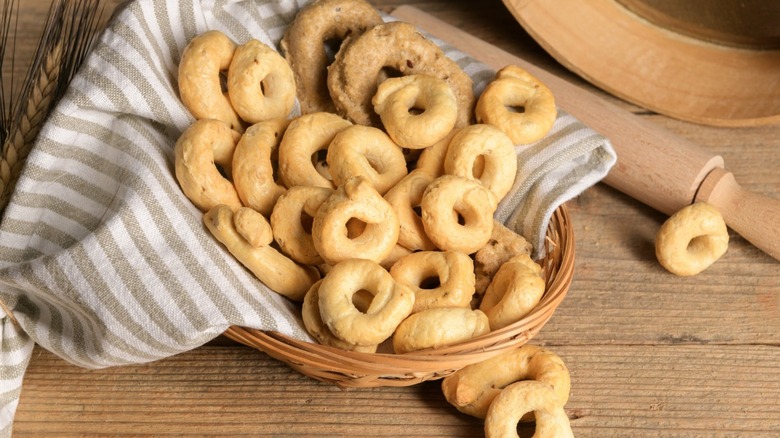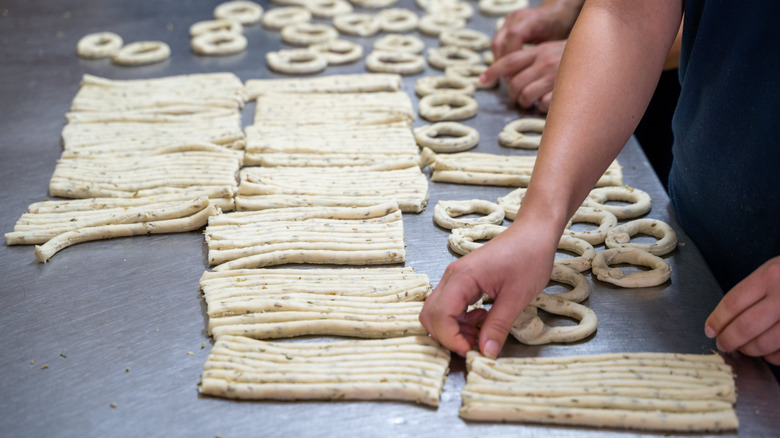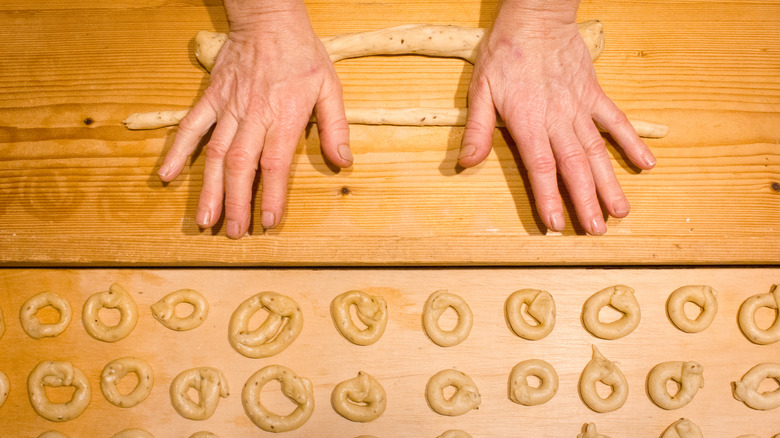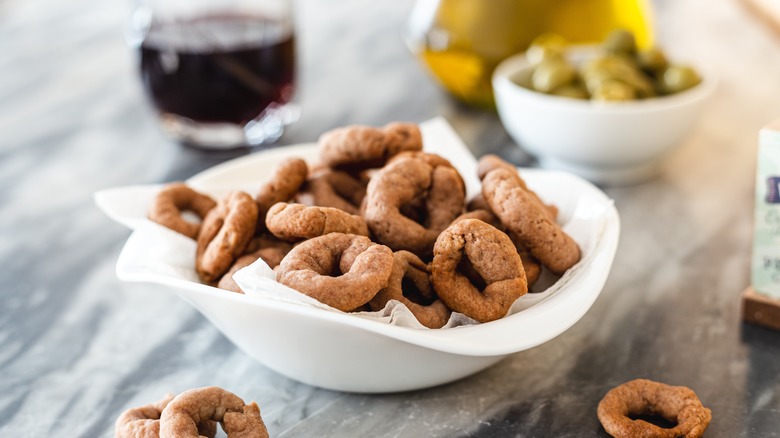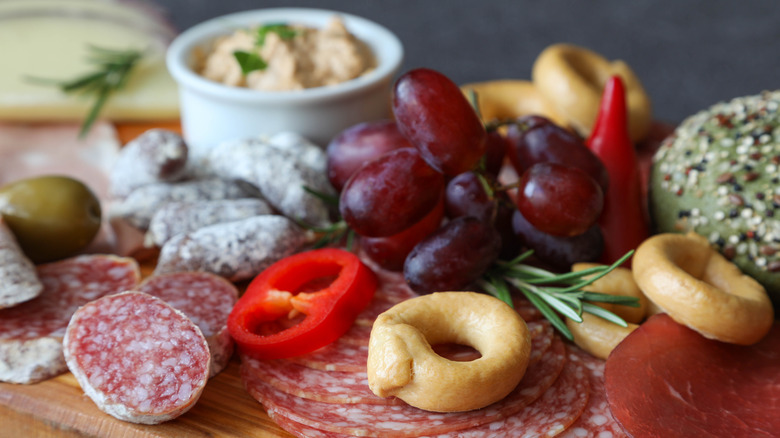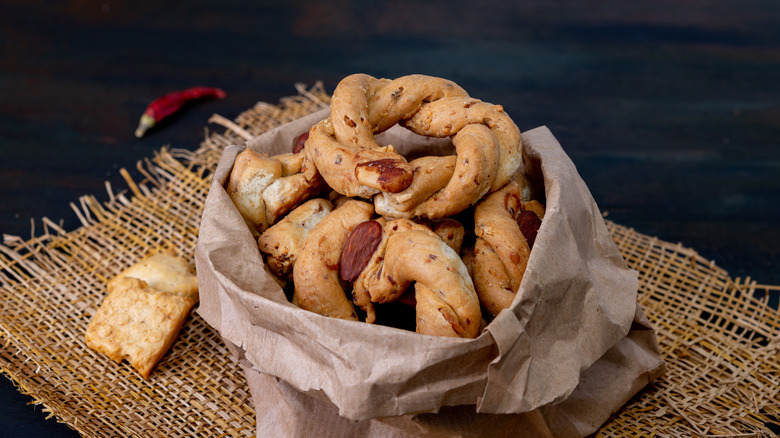What Are Taralli And What Do They Taste Like?
A super unique Italian treat, taralli (or, when pronounced in an Italian-American dialect, ta-rahl) are a crispy, crunchy delight. The cracker-like snacks are made from a simple dough in both sweet and savory permutations, with the sweetened variation being flavored with a touch of sugar and the savory variations infused primarily with anise or fennel, plus black pepper and salt.
Almost like a mix between a pretzel and a breadstick, the dense, donut-shaped item is often made with nothing more than flour, salt, extra virgin olive oil, and white wine, as Italy Magazine notes. If you've tried taralli and have trouble classifying them into one food group, you're not alone: The Chicago Tribune says taralli are "hard to describe to the uninitiated," as they share qualities with crackers, breadsticks, and twice-cooked, British-style biscuits. Special indeed, taralli may once have been offered up to the gods in ancient Greek and Roman tradition, per Tavola Mediterranea. Today, they're mainly celebrated for their taste, convenience, and nostalgic familiarity.
What are taralli's origins?
MasterClass notes that taralli hail from Bari, which is the capital of the Puglia region along the Adriatic Sea in southeastern Italy. The first-ever tarallo, according to Visit Italy, can be dated back to 1400, when a woman gathered what was in her kitchen and made something innovative with the simplest ingredients. (Tavola Mediterranea, however, reveals evidence that taralli may have been developed as long as 2,600 years ago: An almost identical cracker was excavated from a 6th century B.C. archaeological site in what is now Puglia.) The snack's name has Greek origins from "daratos," referring to bread.
Taralli are the epitome of Italian "cucina povera," a peasant style of cooking that continues to be celebrated today for its use of inexpensive, everyday ingredients to make delicious dishes. Despite its humble origins, the snack exploded in popularity, spreading throughout southern Italy, then all of Italy, and finally across the globe. They are now recognizable worldwide as their trademark shape peeks through cellophane bags. While they're easy to find throughout Italy, Palo del Colle, not far from Bari, is known as the most taralli-centric place in the country due to its many bakeries producing the specialty.
How are taralli made?
When it comes to ingredients, the taralli recipe couldn't be simpler, containing just flour, salt, oil, and, in many instances, white wine at their most basic form (which MasterClass says offers a subtle tangy flavor). Of course, depending on the variety you're looking to make, there are additional ingredients used from there. After the dough is mixed and kneaded, small portions are torn off and rolled into thin ropes, which are fused to make a ring shape. Next, the taralli are briefly cooked in boiling water before being cooled, dried, and baked. They're then ready to enjoy.
Though this is the standard, most traditional recipe, other regions and families have their variations. A Chicago Tribune reporter said their grandmother from the Campania region left out of the wine, added yeast, and skipped the boiling process, letting them rise instead. Most recipes swear by the dual-process cooking technique, though. Some say the boiling process helps achieve taralli's trademark crispness, while an Italian blogger says it makes them smoother in texture.
What do taralli taste like?
Taralli are amazingly crisp and crunchy (they can often make a little mess, so be sure to serve with lots of napkins), but their flavor profile can range exponentially depending on the flour they use and their additional ingredients. At their most basic, they taste like an olive oil breadstick, but with a much heartier, snackable consistency. In addition to the customary fennel seed flavor, other popular mix-ins to taralli dough are olives, tomatoes, chili, herbs and spices, and even cacio e pepe flavoring. Dessert variations, or taralli dolci, per Italy Magazine, include sugar and lemon zest. You can even find chocolate taralli.
It's impossible to nail down a singular type of taralli, and that's part of the appeal. Every tarallaro, or taralli vendor, produces a unique type. They can range from olive-sized to tennis ball-sized and look different depending on where you try them. Nonna Box notes that the Campania region is known for braided, sweet taralli (almond is a popular flavoring), while parts of Puglia serve taralli with capocollo for a savory treat, and Calabria has a soft version.
How are taralli served?
An iconic component of southern Italian aperitivo culture, taralli are an excellent pairing alongside an Aperol or Campari spritz, sparkling wine, beer, or any other aperitif. The sweeter versions, especially, would go well with morning coffee or tea, and they'd present a lighter dessert option for house guests who aren't in the mood for anything rich at the end of the meal.
Taralli are a great way to shake up charcuterie boards beyond the classic water cracker, baguette, or cheese wafer. They add an uber-crisp texture to anything they're paired with, complementing soft cheeses and silky cured meats. Add olives, dried fruits, and spreads to the mix, and your antipasti platter is complete.
Mostly, though, taralli are a satisfying snack to tide you over before a meal. If you have friends coming over, pour the wine and set out a bowl of taralli to nod to the snack's roots as a tavern staple (via Nonna Box).
Where to find taralli
Clearly, taralli are simple enough to make at home. Just warm up your kneading arm to make the dough, then invite an assembly line (AKA friends and family) over to roll out a big, shareable pile of taralli. If you're not in the mood for a baking project, taralli are fortunately getting easier to buy in the U.S.
While the crackers are sold plentifully by the barrel-full throughout southern Italian street markets, they have made their way Stateside — even Trader Joe's sells taralli as part of an Italian snack mix, while Whole Foods carries a cacio e pepe flavor. If you'd prefer to buy them from a small business, you should have luck at most Italian food stores. In heavily Italian-American enclaves throughout New Jersey, one especially popular family company producing the historic item is Racioppi's. As the website indicates, the bakery has been producing taralli for over 75 tears and was awarded the best in the state in the '90s.
